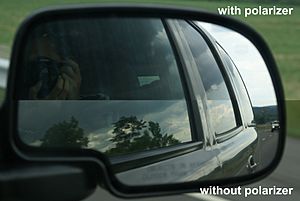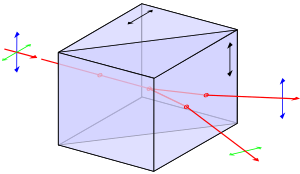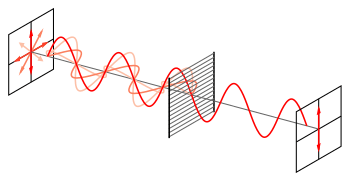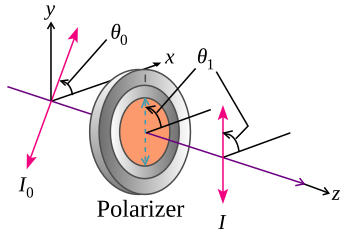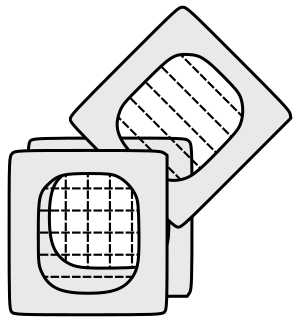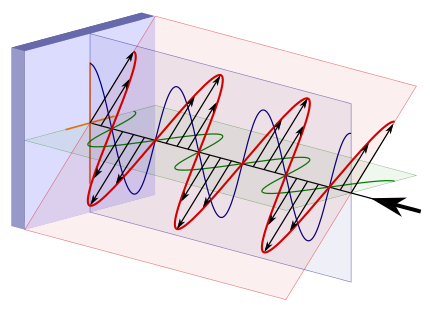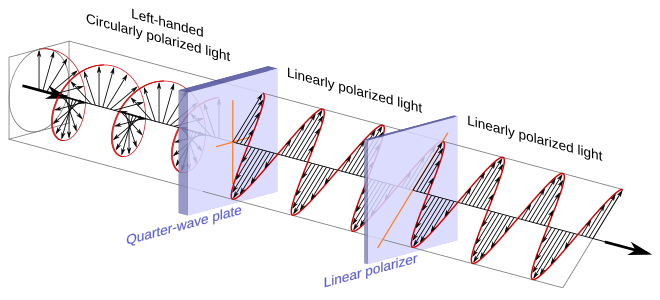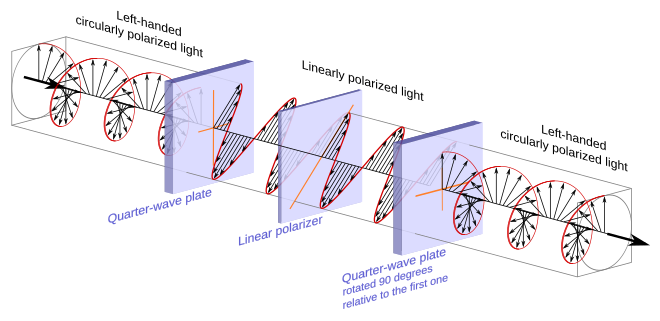Polarizer facts for kids
A polarizer is a special kind of optical filter. It works like a gate for light waves. It only lets light waves with a specific direction of vibration (called polarization) pass through. It blocks or weakens light waves vibrating in other directions. This means it can turn regular, mixed light into light that vibrates in a very specific way, which is called polarized light.
There are two main types of polarizers: linear polarizers and circular polarizers. Polarizers are used in many optical tools and technologies. For example, you'll find them in camera filters and LCD screens. They can also be made for other types of waves, like radio waves or X-rays.
Linear Polarizers
Linear polarizers let light waves pass through only if they vibrate in a straight line. They come in two main types:
- Absorptive polarizers: These soak up the light waves that are vibrating in the wrong direction.
- Beam-splitting polarizers: These split the incoming light into two separate beams, each with a different polarization.
Absorptive Polarizers
Some special crystals can act as linear polarizers. They have a property called dichroism, which means they absorb light differently depending on its polarization. For example, the crystal tourmaline does this, but it also adds color to the light.
A common type of absorptive polarizer is the Polaroid filter. It works like a tiny fence for light. Modern Polaroid filters are made from a plastic called polyvinyl alcohol (PVA) mixed with iodine. When the plastic is stretched during manufacturing, its long chains line up in one direction. Electrons from the iodine can move easily along these chains.
So, if light vibrates parallel to the chains, it gets absorbed. But if light vibrates perpendicular (at a right angle) to the chains, it passes through. Polaroid filters are very common because they are strong, practical, and much cheaper than other types. You can find them in sunglasses, camera filters, and LCD screens.
Newer absorptive polarizers use tiny, stretched silver nano-particles embedded in glass. These are even stronger and can polarize light much better. They are often used for infrared light in optical fiber communications.
Beam-Splitting Polarizers
Beam-splitting polarizers divide an incoming light beam into two separate beams. Each of these new beams has a different type of linear polarization. Ideally, both output beams would be perfectly polarized. However, with many common beam-splitting polarizers, only one of the two beams is fully polarized. The other beam might still have a mix of polarization states.
Unlike absorptive polarizers, beam-splitting polarizers don't absorb the unwanted light energy. This makes them better for use with very strong light, like laser beams. They are also useful when you need to use or study both polarized light components at the same time.
Polarization by Reflection
When light bounces off (reflects from) the surface between two clear materials, like air and glass, the amount of reflection can be different for different polarizations. Light that vibrates in the same plane as the incoming and reflected rays is called p-polarized. Light that vibrates perpendicular to this plane is called s-polarized.
At a special angle called Brewster's angle, no p-polarized light is reflected. This means all the light that reflects at this angle must be s-polarized.
You can make a simple linear polarizer by stacking several glass plates and tilting them at Brewster's angle. Each time light reflects off a surface, some of the s-polarized light is reflected away. This leaves more p-polarized light in the light that passes through. It takes many plates to get a good amount of polarization this way. For example, with 10 plates, only about 3% of the s-polarized light would pass through.
Birefringent Polarizers
Other linear polarizers use the special properties of crystals like quartz and calcite. These crystals are birefringent, meaning they split a beam of unpolarized light into two rays when it enters them. This is called double refraction. Each ray travels at a different speed and has a different refractive index. These two rays are usually in different polarization states.
The Nicol prism was an early type of birefringent polarizer. It's made from a calcite crystal cut in a special way and glued back together. The crystal is designed so that one ray (the "ordinary" ray) hits the glue layer and is completely reflected away. The other ray (the "extraordinary" ray) passes straight through. Nicol prisms produce very pure polarized light. They were used a lot in microscopy but have mostly been replaced by newer prisms like the Glan–Thompson prism.
A Wollaston prism is another birefringent polarizer. It's made of two triangular calcite prisms glued together. When unpolarized light enters, it splits into two linearly polarized rays. These rays leave the prism at different angles. Other similar prisms include the Rochon prism and Sénarmont prism. These prisms truly split the light into two fully polarized beams with perpendicular polarizations.
Thin Film Polarizers
Thin-film linear polarizers are glass plates with a special optical coating. This coating uses reflection or interference effects to act as a beam-splitting polarizer. These polarizers are often less powerful than Glan-type polarizers, but they are cheaper and provide two beams that are almost equally well polarized.
Wire-Grid Polarizers
One of the simplest linear polarizers is the wire-grid polarizer (WGP). It's made of many thin, parallel metal wires placed very close together. WGPs mostly reflect the light that isn't supposed to pass through.
Here's how they work:
- If the electric field of a light wave vibrates parallel to the wires, it makes electrons move along the wires. The wires then act like a metal surface and reflect the light.
- If the electric field vibrates perpendicular (at a right angle) to the wires, the electrons can't move much across the wires. So, the light passes through the grid.
This means the light that passes through is linearly polarized with its electric field vibrating completely perpendicular to the wires. The wires must be closer together than the wavelength of the light for this to work well. Wire-grid polarizers are easy to make for microwaves and infrared light. Modern techniques can also make them for visible light. They are good for wide ranges of light because their polarization doesn't change much with wavelength or angle.
Malus's Law
Malus's law, named after Étienne-Louis Malus, describes what happens when polarized light passes through a perfect polarizer. It says that the brightness (or irradiance, I) of the light that passes through is given by:
Here, I0 is the original brightness of the light. θi is the angle between the light's original polarization direction and the direction the polarizer lets light through.
If you have regular, unpolarized light, you can think of it as having light vibrating in all possible directions. When this light passes through a polarizer, about half of its brightness will get through. In real life, some light is always lost, so the actual amount that passes through is a bit less than half.
If you place two polarizers one after another, the angle between their polarizing directions determines how much light passes through. If their directions are at right angles (90 degrees), they are called crossed polarizers. In theory, no light should pass through. However, real polarizers are not perfect, so a tiny bit of light might still get through. If you put a clear object between crossed polarizers, any special polarization effects in the object (like birefringence) will show up as an increase in light passing through. This is used in tools called polarimeters to measure how a sample affects polarized light.
Real polarizers also don't completely block the unwanted polarization. The ratio of the unwanted light that gets through to the wanted light is called the extinction ratio. For Polaroid filters, it's about 1:500, meaning 1 part of unwanted light for every 500 parts of wanted light. For very high-quality prisms, it can be as good as 1:1,000,000.
Circular Polarizers
Circular polarizers (often called CPL filters) are used to create circularly polarized light. They can also selectively absorb or let through light that is circularly polarized in a clockwise or counter-clockwise direction.
You might have seen them in 3D glasses used for some stereoscopic movies, like RealD 3D. In these movies, the polarization of light helps send different images to your left and right eyes, creating the 3D effect. They are also used as polarizing filters in photography to reduce reflections from non-metal surfaces.
Creating Circularly Polarized Light
The most common way to create circularly polarized light is by using a quarter-wave plate after a linear polarizer. First, regular light passes through the linear polarizer, becoming linearly polarized. Then, this linearly polarized light enters the quarter-wave plate.
For this to work, the direction the linear polarizer lets light through must be at a 45-degree angle to the special "fast" and "slow" axes of the quarter-wave plate.
Imagine the linearly polarized light as having two parts: a horizontal part and a vertical part. These two parts vibrate together at first. The quarter-wave plate is made of a birefringent material. This means light travels at different speeds depending on how its electric field is vibrating. So, one part (say, the horizontal part) will travel slower than the other (the vertical part).
As the light passes through the quarter-wave plate, the slower part falls behind the faster part. The thickness of the plate is set so that when the light leaves, one part is exactly one-quarter of a wavelength behind the other. This quarter-wavelength delay makes the light become circularly polarized.
In circularly polarized light, the strength of the electric field stays the same, but its direction steadily rotates as the wave travels.
If you look at the light from the receiver's side, it can be either left-handed (rotating counter-clockwise) or right-handed (rotating clockwise). To change from left-handed to right-handed, you just rotate the quarter-wave plate by 90 degrees relative to the linear polarizer.
Absorbing and Passing Circularly Polarized Light
Circular polarizers can also be used to selectively absorb or pass light that is already circularly polarized. This is how 3D glasses in cinemas work. A polarizer that creates a certain type of circularly polarized light will also let that same type of light pass through if it comes from the other direction. But it will block light with the opposite polarization.
When circularly polarized light enters a quarter-wave plate, it is always changed into linearly polarized light. The direction of this linearly polarized light depends on the orientation of the quarter-wave plate and the "handedness" of the incoming circularly polarized light.
For example, if left-handed circularly polarized light enters the polarizer, it's changed into linearly polarized light that is aligned with the transmission direction of the linear polarizer part. So, it passes through. If right-handed circularly polarized light entered, it would be changed into linearly polarized light that is aligned with the absorbing direction, and it would be blocked.
To make a circular polarizer that passes right-handed light and blocks left-handed light, you simply rotate the quarter-wave plate and linear polarizer by 90 degrees relative to each other.
Homogeneous Circular Polarizer
A homogeneous circular polarizer is a special type that lets one specific "handedness" of circular polarization pass through completely unchanged, while blocking the other. It's like a linear polarizer that lets one angle of linear light pass and blocks the perpendicular angle.
You can make a homogeneous circular polarizer by putting a linear polarizer between two quarter-wave plates. The first quarter-wave plate changes the incoming circularly polarized light into linearly polarized light. The linear polarizer then blocks the unwanted linear polarization. Finally, the second quarter-wave plate changes the remaining linearly polarized light back into its original circular polarization. This type of polarizer works the same way no matter which direction the light comes from.
Circular and Linear Polarizing Filters for Photography
Linear polarizing filters were the first type used in photography. They still work well with older cameras that don't have special light-measuring or focusing systems inside the lens.
However, most modern cameras, like digital SLRs (DSLRs), use systems that measure light and focus through the lens (called TTL metering and autofocus). These systems rely on light that is linearly polarized in a specific way. If the light entering the camera is already linearly polarized by an old-style filter, it can confuse these systems and lead to incorrect exposure or blurry photos.
This is why circular polarizing filters are used with modern cameras. They still cut out linearly polarized light to darken skies, make colors richer, and remove reflections. But the light they pass through is circularly polarized, which doesn't interfere with the camera's internal metering and autofocus systems.
See also
 In Spanish: Filtro polarizador para niños
In Spanish: Filtro polarizador para niños
- Fresnel rhomb – another way to make circularly polarized light.
- Polariscope – a tool that uses polarizers to study materials.
- Polarized light microscope – a microscope that uses polarized light.


